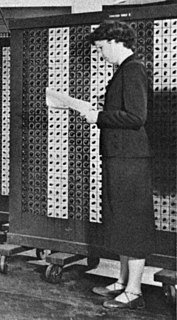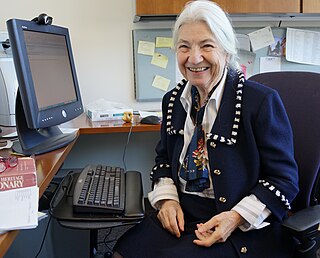Related Research Articles

The Semi-Automatic Ground Environment (SAGE) was a system of large computers and associated networking equipment that coordinated data from many radar sites and processed it to produce a single unified image of the airspace over a wide area. SAGE directed and controlled the NORAD response to a Soviet air attack, operating in this role from the late 1950s into the 1980s. Its enormous computers and huge displays remain a part of cold war lore, and a common prop in movies such as Dr. Strangelove and Colossus.

Whirlwind I was a Cold War-era vacuum tube computer developed by the MIT Servomechanisms Laboratory for the U.S. Navy. Operational in 1951, it was among the first digital electronic computers that operated in real-time for output, and the first that was not simply an electronic replacement of older mechanical systems.

MIT Computer Science and Artificial Intelligence Laboratory (CSAIL) is a research institute at the Massachusetts Institute of Technology (MIT) formed by the 2003 merger of the Laboratory for Computer Science (LCS) and the Artificial Intelligence Laboratory. Housed within the Ray and Maria Stata Center, CSAIL is the largest on-campus laboratory as measured by research scope and membership. It is part of the Schwarzman College of Computing but is also overseen by the MIT Vice President of Research.

Frances Elizabeth Holberton was one of the six original programmers of the first general-purpose electronic digital computer, ENIAC. The other five ENIAC programmers were Jean Bartik, Ruth Teitelbaum, Kathleen Antonelli, Marlyn Meltzer, and Frances Spence.

Ruzena Bajcsy is an American engineer and computer scientist who specializes in robotics. She is Professor of Electrical Engineering and Computer Science at the University of California, Berkeley, where she is also Director Emerita of CITRIS.
Phyllis Ann Fox is an American mathematician and computer scientist.
C. Robert Wieser qualified from MIT as an electrical engineer and later became a developer of electrical and computing technology. He is especially and particularly noted for having contributed to the development of the Cape Cod Air Defense system and SAGE system.
Jean Bacon is a British emeritus professor of distributed systems at the Computer Laboratory at the University of Cambridge, where she co-headed the Opera Research Group from its founding in the 1990s. Previously, she taught at Hatfield Technical College where, in the 1970s, she was involved in the design of one of the earliest computer science degree programs offered in the United Kingdom. Bacon retired from her faculty position at Cambridge in 2010 but has continued to work on Opera projects related to distributed systems and security in cloud computing.
Janet Abbate is an associate professor of science, technology, and society at Virginia Tech. Her research focuses on the history of computer science and the Internet, particularly on the participation of women in the field.
Hilary J. Kahn (1943–2007) was a British computer scientist who spent most of her career as a professor at the University of Manchester, where she worked on computer-aided design and information modelling. Kahn participated in the development of the Manchester MU5 computer. Later she became involved in standards development and was both the chair of the Technical Experts Group and a member of the Steering Committee for the development of the EDIF standard. Kahn retired from Manchester in 2006 and died in 2007.
David Randolph Brown was an American computer scientist. He was a member of the Massachusetts Institute of Technology leadership team that created Project Whirlwind, "one of the first large-scale, high-speed computers".
Gillian Lovegrove is a retired computer scientist and academic. She was Dean of the School of Informatics at Northumbria University, president of the Conference of Professors and Heads of Computing and was Higher Education consultant to the British Computer Society and manager of its Education and Training Forum. She is known for her interest in gender imbalance in computer education and employment, and her public discussion of possible solutions to a shortage of information technology graduates in the UK.
Eleanor D. L. Ireland was an early British computer scientist and member of the Women's Royal Naval Service.
Elsie Shutt is an American computer programmer and entrepreneur who founded Computations Incorporated (CompInc) in 1957, when she was not permitted to work part-time at home after she became pregnant. Shutt was notably one of the first women to start a software business not only in the United States but the entire world.
Ann Hardy is an American computer programmer and entrepreneur, best known for her pioneering work on computer time-sharing systems while working at Tymshare from 1966 onwards.
Sylvia B. Wilbur was a British computer scientist who helped develop the ARPANET, was one of the first to exchange email in Britain, and became a leading researcher on computer-supported cooperative work.
Marlene Hazle was an American known for her work in computer science throughout the 20th century. She worked at RAND Corporation and Mitre Corporation for development of the Semi-Automatic Ground Environment and AESOP respectively. Hazle eventually became a supervisor and trained military personnel on the SAGE operating system. Hazle continued making contributions to the fields of computer science and aerospace throughout the 20th century.
Susan Bond, was a scientific officer and computer programmer for the Mathematics Division of the Royal Radar Establishment (RRE) in the United Kingdom. She worked extensively on the programming language ALGOL 68 and the Royal Radar Establishment Automatic Computer (RREAC), an early solid-state electronics, ICL 1907F computer.
Bobby Hersom is a British mathematician and computer scientist known for her early work on computers at Elliott Brothers, Hatfield Polytechnic, and the Rothamstead Agricultural Research Station.

Perry Orson Crawford, Jr. was an American computer pioneer credited as being the first to fully realize and promote the value of digital, as opposed to analog, computers for real-time applications. This was in 1945 while advising Jay Forrester in developing flight simulators and anti-aircraft fire control devices during World War II, before practical digital computers had been produced. His similar foresight on related issues led to his heading twelve years later the design team for IBM's SABRE project, the ticketing system for American Airlines, the first large-scale commercial application of real-time computer systems, which became the model for on-line transaction processing.
References
- 1 2 3 Clapp, Judy (11 February 2001). "Oral History: Judy Clapp". IEEE History Center Oral History Program (Interview). Interviewed by Janet Abbate. Lexington, MA.
- 1 2 3 "SWE Awards: 2001 Achievement Award" (PDF). Society of Women Engineers. Retrieved 1 September 2015.CS1 maint: discouraged parameter (link)
- ↑ Sloan, editors, Mary Zeiss Stange, Carol K. Oyster, Jane E. (2011). Encyclopedia of women in today's world . Thousand Oaks, Calif.: Sage Reference. pp. 323–4. ISBN 9781412976855.CS1 maint: extra text: authors list (link)
- ↑ Denise, Gürer (1995). "Pioneering Women in Computer Science" (PDF). Communications of the ACM. 38 (1): 45–54. doi:10.1145/204865.204875. S2CID 6626310.
- ↑ "Smith History: The Smith College Medal" . Retrieved May 10, 2016.CS1 maint: discouraged parameter (link)
- ↑ Abbate, Janet (2012-10-19). Recoding Gender: Women's Changing Participation in Computing. MIT Press. ISBN 978-0-262-30453-5.